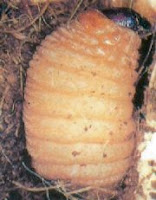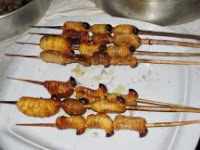 |
| Suri grub |
Suri are the grubs of palm beetles, Rhynchophorus palmarum, which grow in the stumps of chonta palms, Euterpe spp., that have been felled to harvest their edible palm hearts. The palm hearts are delicious. The grubs are fat, pale, curved, and large — up to five inches long. They are eaten by first using the thumb and forefinger to crush their mahogany brown head, which has a nasty pair of pincers; slicing the thin skin of the body with the thumbnail and opening it up lengthwise; plucking out the brown thread of the intestinal tract; and sucking out the white gelatinous contents. This is considered a great delicacy.
These internal contents are very greasy; I myself do not relish raw suri. But suri can also be readily cooked in a pan, where they fry in their own fat, like bacon. Fried suri with ajo sacha, wild garlic, can be quite tasty. In markets throughout the Upper Amazon, vendors with small charcoal barbecues offer suri-on-a-stick. Famed ethnobotanist James A. Duke says, “Cooked, they are a great treat; better than fried oysters.”
 |
| Suri-on-a-stick |
Indeed, Duke has proposed the development of renewable suriculture in the Amazon. Approximately 62 percent of the suri grub is protein. Insect fatty acids are highly unsaturated. Suri are rich in thiamin, zinc, riboflavin, copper, iron, and niacin. My jungle survival instructor, Gerineldo Moises Chavez, told me that it is impossible to starve in the jungle, and it seems he is right.
This has nothing to do with shamanism. I just thought it was interesting.

- Previous Post: Olivier Messiaen
- Next Post: Steam Baths
- More Articles Related to: Jungle Survival, The Amazon



Yummi!!
I grew up eating tantarrias, a very stinky bug that you have to boil for hours to wash away the stench, then you fry them and they are awesome.
I also ate honey ants and agave worms.However my favorites are toasted grasshopers withchile, onio and lime in a corn tortilla. you can’t go wrong with these!
When my wife and I were canoeing the Green River one summer, we would beach and turn over the canoes at the end of the day. In the morning there would thousands of crickets hiding in the shade of the canoe as the sun came up. We would heat up a frying pan of hot sesame oil and toss handfuls of crickets into the pot. They tasted like spicey popcorn.
This is a fascinating post. I spent two weeks in the Andes in very remote regions and wish I had come across insects to eat but it appears they’re only in the jungles. Dang! Time to head to the Amazonian Basin. I’d like to communicate further with respect to entomophagy. Anyone interested please contact me at my organization’s website: Insects Are Food: http://www.insectsarefod.com
Thank you.